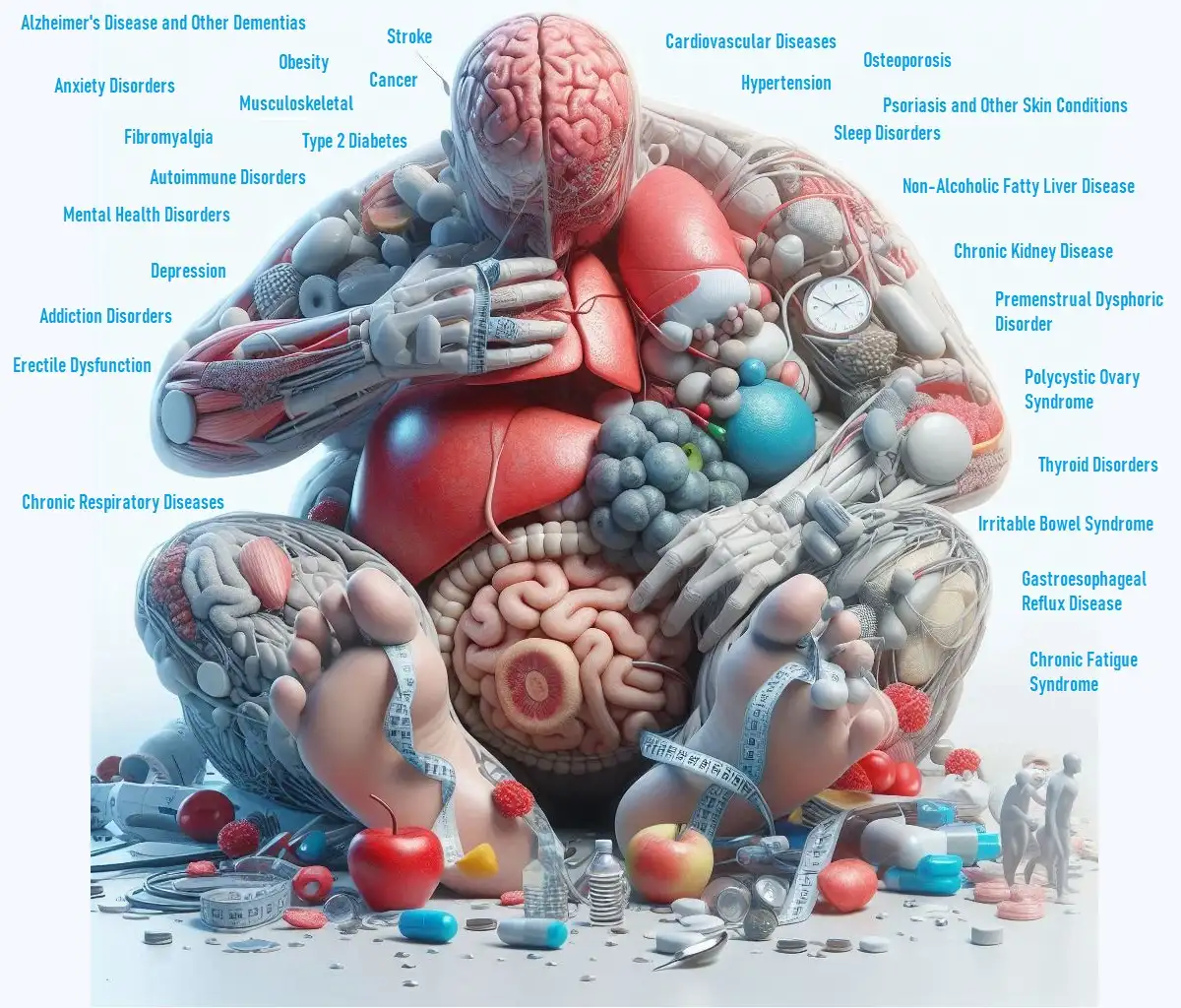
Obesity is a complex and multifaceted condition influenced by many factors, from our internal body clocks to gut health. This article delves into how circadian rhythms, brown fat, gut permeability, and even skin health are connected to obesity. We’ll explore these topics in detail and provide practical tips to help you manage or prevent obesity.
Key Takeaways
- Circadian Rhythms: Disruptions to your natural body clock can influence weight gain.
- Brown Fat: This special type of fat plays a role in managing body weight.
- Gut Permeability: A healthy gut is crucial for maintaining a healthy weight.
- Venous Health: Obesity can lead to chronic venous insufficiency, complicating overall health.
- Skin Health: Obesity affects your skin, leading to various disorders.
The Impact of Circadian Rhythms on Obesity
What Are Circadian Rhythms?
Circadian rhythms are your body’s internal clock, regulating sleep-wake cycles, hormone release, and other bodily functions. These rhythms are influenced by external cues like light and temperature, and they play a crucial role in your overall health.
How Circadian Rhythms Affect Weight
When your circadian rhythms are out of sync—say, due to irregular sleep patterns or shift work—it can lead to weight gain. Here’s how:
- Disrupted Sleep: Poor sleep can affect hunger hormones, increasing your appetite and cravings, particularly for unhealthy foods.
- Metabolism: Your metabolism follows a daily rhythm. Eating late at night, when your metabolism slows down, can contribute to weight gain.
- Insulin Sensitivity: Insulin sensitivity fluctuates throughout the day. Eating at irregular times can lead to impaired insulin response, increasing the risk of obesity.
Tips for Aligning Circadian Rhythms
- Consistent Sleep Schedule: Go to bed and wake up at the same time every day to regulate your body clock.
- Morning Light Exposure: Spend time in natural sunlight early in the day to help reset your circadian rhythms.
- Avoid Late-Night Eating: Try to eat your last meal at least two to three hours before bedtime.
Obesity and Chronic Venous Insufficiency
Understanding Chronic Venous Insufficiency (CVI)
Chronic venous insufficiency occurs when the veins in your legs don’t work effectively, making it hard for blood to return to the heart. This condition often leads to swelling, pain, and skin changes.
How Obesity Contributes to CVI
Obesity puts extra pressure on your veins, particularly in the legs, making it harder for blood to flow back to the heart. This increased pressure can damage the valves in your veins, leading to CVI.
- Increased Venous Pressure: Excess body weight adds pressure on leg veins, causing blood to pool and leading to venous insufficiency.
- Inflammation: Obesity-related inflammation can weaken vein walls and valves, worsening CVI symptoms.
- Reduced Mobility: Obesity often reduces physical activity, which is essential for healthy blood circulation.
Managing Obesity-Related CVI
- Weight Loss: Losing weight can reduce the pressure on your veins, alleviating symptoms of CVI.
- Compression Stockings: Wearing compression stockings can help improve blood flow in the legs.
- Exercise: Regular physical activity, particularly exercises that engage the leg muscles, can help manage CVI.
The Role of Brown Fat in Obesity Management
What Is Brown Fat?
Unlike white fat, which stores energy, brown fat burns calories to generate heat. It’s more active in babies and decreases as we age, but activating brown fat can be a key factor in managing obesity.
How Brown Fat Helps with Weight Management
Brown fat can burn calories and help regulate body weight. Here’s how it works:
- Calorie Burning: Brown fat burns calories by generating heat, helping you manage or lose weight.
- Metabolism Boost: Activating brown fat can boost your metabolism, making it easier to burn fat and manage weight.
- Glucose Regulation: Brown fat helps regulate blood sugar levels, reducing the risk of obesity-related diseases like diabetes.
Activating Brown Fat
- Cold Exposure: Regular exposure to cold temperatures can stimulate brown fat activity. Try taking cold showers or spending time in a cool environment.
- Exercise: Physical activity can help activate brown fat, particularly exercises that increase your core body temperature.
- Certain Foods: Some studies suggest that foods like capsaicin (found in chili peppers) can stimulate brown fat activity.
Impact of Gut Permeability on Obesity
Understanding Gut Permeability
Gut permeability, often referred to as “leaky gut,” occurs when the lining of the gut becomes compromised, allowing toxins and bacteria to enter the bloodstream. This can lead to inflammation and a host of other health issues, including obesity.
How Leaky Gut Contributes to Obesity
A leaky gut can contribute to obesity by:
- Inflammation: Increased gut permeability can trigger inflammation, which is linked to weight gain and obesity.
- Impaired Nutrient Absorption: A compromised gut lining can affect the absorption of nutrients, leading to imbalances that promote weight gain.
- Hormonal Imbalance: A leaky gut can disrupt the balance of hormones related to hunger and metabolism, leading to increased appetite and weight gain.
Improving Gut Health to Combat Obesity
- Probiotics and Prebiotics: Consuming foods rich in probiotics (like yogurt) and prebiotics (like fiber-rich foods) can improve gut health.
- Reduce Processed Foods: Cut down on processed foods, which can damage the gut lining and contribute to leaky gut.
- Stay Hydrated: Proper hydration supports a healthy gut lining and aids in digestion.
Obesity and Skin Disorders: The Connection
How Obesity Affects Skin Health
Obesity can lead to various skin disorders, including:
- Acanthosis Nigricans: This condition causes dark, thick patches of skin, usually in areas where the skin folds, such as the neck or armpits.
- Skin Infections: Obesity increases the risk of skin infections due to the increased skin folds, which can trap moisture and create a breeding ground for bacteria and fungi.
- Stretch Marks: Rapid weight gain can stretch the skin, leading to stretch marks, which can be difficult to treat.
Managing Skin Health in Obesity
- Maintain a Healthy Weight: Losing weight can reduce the risk of obesity-related skin disorders.
- Proper Hygiene: Keep skin clean and dry, particularly in skin folds, to prevent infections.
- Moisturize Regularly: Use moisturizing creams to keep skin hydrated and reduce the risk of dryness and cracking.
Conclusion
Understanding the various factors that contribute to obesity is crucial for effective management. From aligning your circadian rhythms to activating brown fat and maintaining a healthy gut, each of these elements plays a vital role in controlling weight and improving overall health. Addressing skin and venous health is also essential in managing obesity and its associated complications.
By taking a holistic approach to your health—considering everything from diet and exercise to sleep and stress management—you can make significant strides in managing obesity. Stay informed, be proactive, and remember that small, consistent changes can lead to lasting results.















